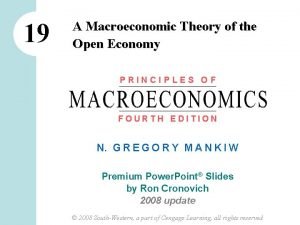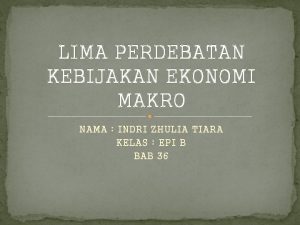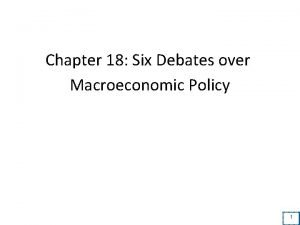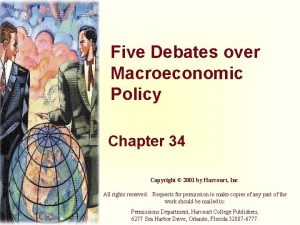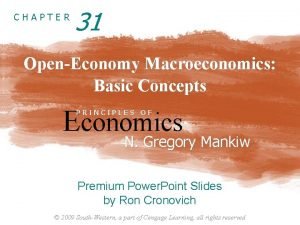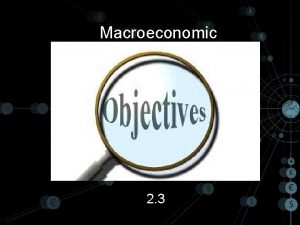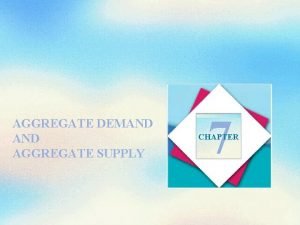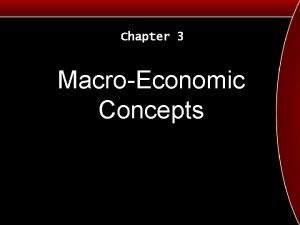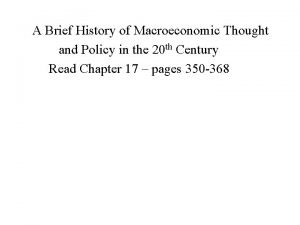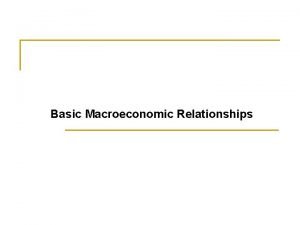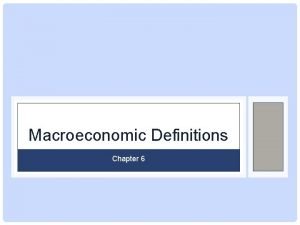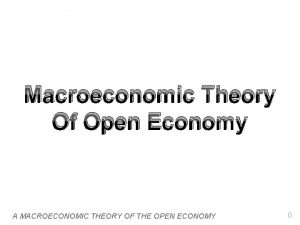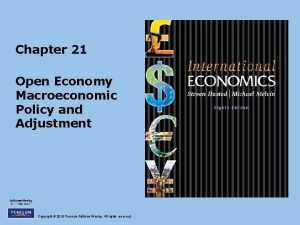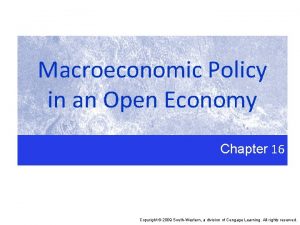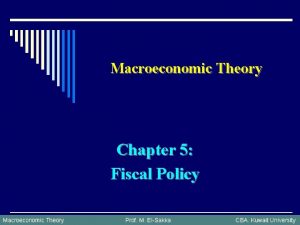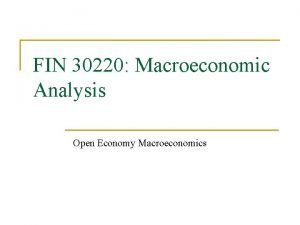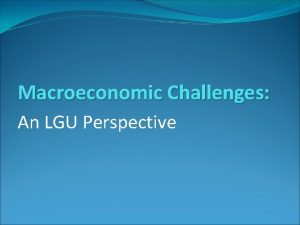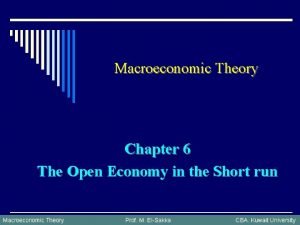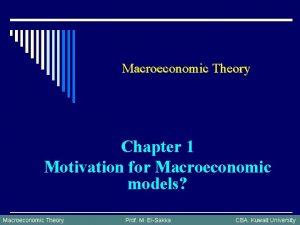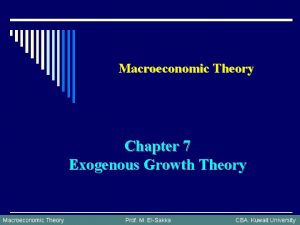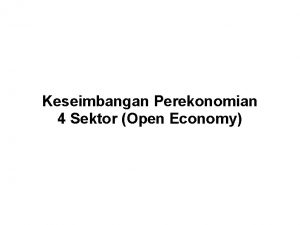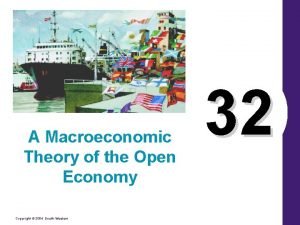Macroeconomic Policy in an Open Economy Chapter 16














- Slides: 14

Macroeconomic Policy in an Open Economy Chapter 16 Copyright © 2009 South-Western, a division of Cengage Learning. All rights reserved.

Economic Objectives o internal balance • fully employed economy • no inflation – or reasonable amount of inflation o external balance – neither a deficit nor a surplus in current account o overall balance – both internal and external balance o other goals: long-run economic growth and equitable income distribution

Policy Instruments o expenditure changing policies – alter aggregate demand for both domestic and international goods and services • fiscal policy – government changes spending and taxation • monetary policy – central bank changes money supply and interest rates o expenditure switching policies – modify direction of demand between domestic output and imports; example: currency depreciation o direct controls – government restrictions on economy; example: tariffs

Expansionary Policy in Closed Economy o to increase output and reduce unemployment central bank increases money supply decreasing interest rates o leads to increased AD o more AD leads to increased GDP o fiscal policy alternatives would be to increase government spending or decrease taxes

Expansionary Fiscal Policy with Fixed Exchange Rates o secondary effect is an increased budget deficit which increases interest rates o attracts more foreign investment o increases demand for domestic currency o fixed exchange rates require government purchase foreign currency o increases money supply further increasing AD

Expansionary Monetary Policy with Fixed Exchange Rates o to increase AD interest rates are decreased o discourages foreign investment o decreases demand for dollars o fixed exchange rate system requires government use foreign currency reserves to purchase domestic currency o decrease in money supply reduces AD

Expansionary Fiscal Policy with Floating Exchange Rates o initial effect is move from AD 0 to AD 1 o greater deficit leads to increased interest rates o causes inflow of foreign investment o increased demand for domestic currency o appreciation leads to decline in current account o reduced impact of fiscal policy

Expansionary Monetary Policy with Floating Exchange Rates o increase money supply decreases interest rates o causes increase in AD o shift of investments toward other nations o requires sale of domestic currency o resulting depreciation leads to further increase in AD o policy is particularly effective in this case

Summary of Effectiveness Monetary Policy Fiscal Policy Floating Exchange Rate Strengthened Weakened Fixed Exchange Rate Weakened Strengthened

Policy Conflict-Zone recession & current account deficit o under floating exchange rate system expansionary monetary policy causes increase in GDP as well as depreciation improving current account deficit inflation & current account deficit o under floating exchange contractionary monetary policy limits inflation but leads to appreciation increasing current account deficit o policy zone conflict – monetary policy cannot restore both internal and external balance

Inflation with Unemployment o more problematic because internal balance cannot be achieved by managing AD o overall balance requires 1) current account equilibrium 2) full employment 3) price stability o 1971 example of inflation with unemployment o resulting actions: expansionary policy with wage & price controls along with devaluation of the dollar

International Policy Coordination o mobility of goods, services, labor and capital o economic policies of one nation will have impact on economies of other nations o coordination – attempt to modify monetary, fiscal and exchange rate policies recognizing international repercussions

Examples of Policy Coordination o 1984: U. S. expansionary fiscal policy used to address recession o caused appreciation of dollar and current account deficit o Plaza Agreement of 1985 • G-5: U. S. , Japan, Germany, Great Britain, and France • pledges: U. S. – reduce federal deficit Japan – expansionary monetary policy Germany – tax reductions

Examples of Policy Coordination (cont. ) o 1985 -88: dollar decreased 54% o decline in dollar’s value led to concern of more drastic decrease in value o Louvre Accord 1987 U. S. – adopt restrictive fiscal policy Japan – ease monetary policy o U. S. current account deficit began to decline and reached balance by 1991 o coordination efforts may not be successful due to central banks independence and growth of global financial markets
 A macroeconomic theory of the open economy
A macroeconomic theory of the open economy Macroeconomic policy debates
Macroeconomic policy debates Perdebatan kebijakan makro ekonomi
Perdebatan kebijakan makro ekonomi Six debates over macroeconomic policy
Six debates over macroeconomic policy Five debates over macroeconomic policy
Five debates over macroeconomic policy Five debates over macroeconomic policy
Five debates over macroeconomic policy Chapter 31 open economy macroeconomics
Chapter 31 open economy macroeconomics Athenian economy vs sparta economy
Athenian economy vs sparta economy 영국 beis
영국 beis Macroeconomic objectives
Macroeconomic objectives Macroeconomic equilibrium occurs:
Macroeconomic equilibrium occurs: Macroeconomic deals withसमग्रलक्षी
Macroeconomic deals withसमग्रलक्षी History of macroeconomic thought
History of macroeconomic thought Basic macroeconomic relationships
Basic macroeconomic relationships Macroeconomic definitions
Macroeconomic definitions
